The Huawei Honor 8 Review
by Matt Humrick on October 13, 2016 8:00 AM EST- Posted in
- Huawei
- Smartphones
- Mobile
- Kirin 950
- honor
Display
The Honor 8 uses a JDI (Japan Display Inc.) IPS-NEO LCD panel, just like the Huawei P9, which supports in-cell touch (the touchscreen layers are integrated into the display stack instead of existing as separate layers above the display) and panel self-refresh. The panel uses LTPS (Low Temperature Poly-Silicon) TFT technology that features higher carrier mobility than a-Si (amorphous silicon) TFT. This enables higher aperture ratios, allowing the panel to transmit light more efficiently, and because the drive circuits reside on the glass substrate, the black border around the display’s active area is thinner. This particular 5.2-inch panel has a resolution of 1920x1080, giving it a pixel density of 423ppi, which is plenty for an LCD display.
While the Honor 8 uses a high-quality panel, it requires proper calibration if it’s going to deliver excellent image quality. If Huawei fails to set gamma, white point, and RGB balance correctly, grayscale and color accuracy will suffer. To evaluate the display’s performance, we’ll use an X-Rite i1Pro 2 spectrophotometer for color measurements and an i1Display Pro colorimeter for luminance measurements, with SpectraCal's CalMAN 5 software managing the data.
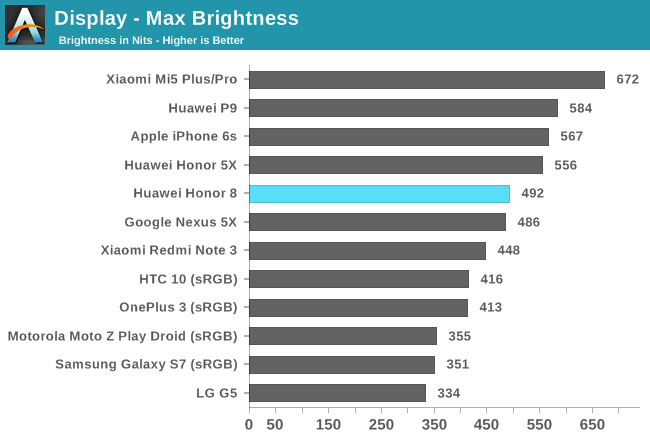
The Honor 8’s maximum brightness is just shy of 500 nits, a decent value that makes the display easy to see in most conditions except direct sunlight. It’s a little disappointing that it cannot match the 550 nit brightness of the less-expensive Honor 5X, and a little curious it falls noticeably short of the P9 with a similar display. The P9’s backlight uses 20 LEDs to increase peak brightness, so either the Honor 8 uses a different backlight assembly or our review samples are just at the extreme ends of hardware variability. At its lowest setting, the Honor 8 drops all the way down to just 3 nits, making it suitable for viewing in a dark room.
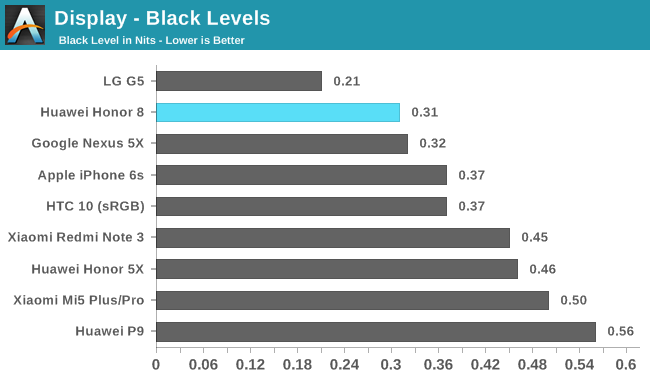
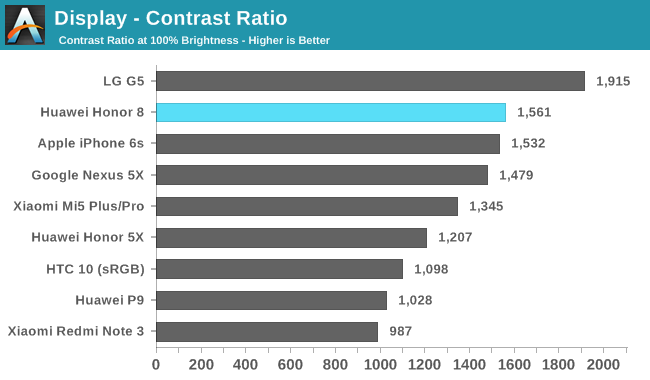
We measure the black level and contrast ratio at maximum brightness, which makes direct black level comparisons more difficult because a display’s black level increases with brightness; however, after normalizing for this effect, the Honor 8’s black level is about the same as the iPhone 6s’ and only slightly higher than the G5’s, giving it a very good contrast ratio overall. It appears the Honor 8’s display makes use of photo-aligned crystals and content-adaptive backlight control (CABC) to improve black levels.
The phones with OLED panels are not shown in these charts because they are able to achieve a black level of zero and a mathematically infinite contrast ratio by being able to completely turn off individual pixels.
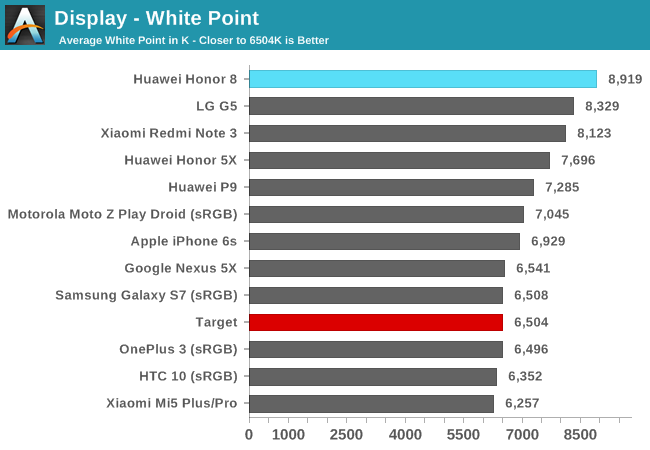
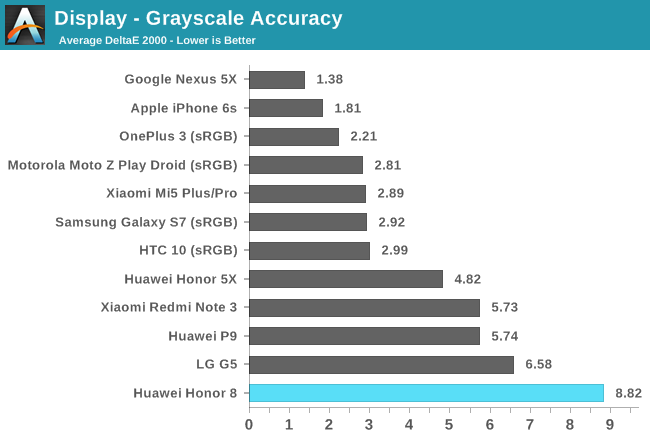
Unfortunately, Huawei continues to ship phones calibrated to an overly cool white point. The Honor 8’s “Default” temperature setting yields an average correlated color temperature (CCT) of almost 9,000K, which is even worse than the LG G5. The elevated levels for the blue and green primary colors and deficit in red give the Honor 8’s display a very obvious blue tint. If the display is not blue enough for you, however, there’s a “Cold” setting that increases the white point to about 9,500K. The “Warm” setting brings the average CCT down to less than 7,800K, but the emphasis on the blue and green primary colors at the expense of red gives the display an odd turquoise tint.
In addition to these three settings, it’s possible to select a custom white point target by dragging a finger around a color wheel. There’s no benefit in doing so, however, because the average CCT will not drop below about 7,900K and it’s impossible to correct the RGB imbalance that makes the screen look blue/turquoise.
The Honor 8’s average ΔE2000 grayscale error of 8.82 at its Default setting (Cold and Warm are even worse) is among the worst we’ve measured in the past few years, with a peak error of about 14 at 100% white. Gamma is a little high too, hovering around 2.3 over the full luminance range, reducing shadow detail and making images look a little darker than they should.
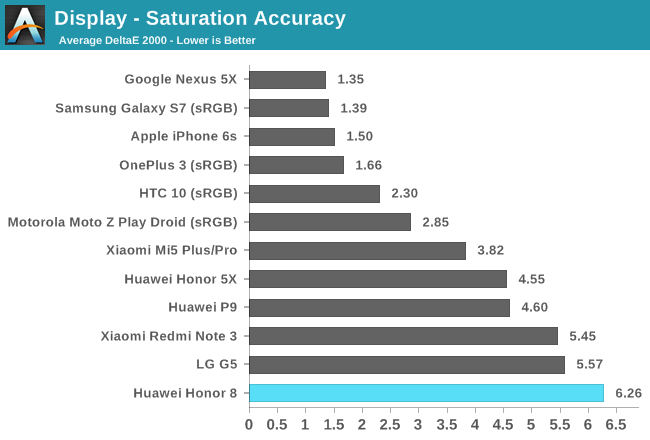
The Honor 8 uses a wide color gamut display that extends coverage for reds and greens but surprisingly comes up short for blues relative to the standard sRGB gamut. The larger gamut coupled with Android’s lack of color management means most colors appear oversaturated by as much as 20%. Shades of red are an exception, with lighter shades appearing undersaturated. Unfortunately, the Honor 8 does not have an sRGB mode, so there’s no way to improve saturation or color accuracy.
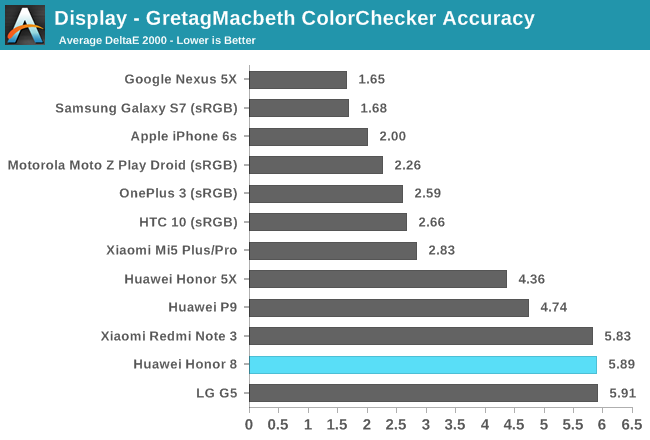
All three of the Huawei phones show poor color accuracy, which is no surprise considering the calibration issues each have with RGB balance and, to a lesser extent, gamma. The Honor 8 and P9 also have wide-gamut displays that oversaturate colors.
Regardless of the color temperature setting, the Honor 8’s display registers a ΔE2000 error above 3 (the threshold where error is generally considered unacceptable) for almost all of the tested colors. Skin tones are particularly bad, which is unfortunate considering how much time we spend using our phones to look at pictures of people. Average color error is similar to the LG G5 and the Xiaomi Redmi Note 3 that’s half the Honor 8’s price.
Many OEMs are now including special display modes that filter out blue light for use at night to reduce eye strain and improve sleep patterns. The Honor 8 includes Huawei’s “Eye comfort” mode for just this purpose, which is definitely warranted given its very cool white point. The RGB balance chart above shows how this mode restricts the blue primary’s output while boosting green and red. The result is a heavily yellow-tinted display with a warm 6000K white point. Grayscale and color accuracy are not the goal here, so we can ignore the grayscale error values. This mode is obviously not suitable for watching movies or viewing pictures; however, it is useful for reading text in low ambient lighting or before going to bed. It does take a few minutes for your eyes to adjust from the radical shift in white point, though.
Our review unit does not show any backlight bleed or issues with luminance uniformity, but its viewing angles are not as good as other IPS displays. In addition to the usual IPS glow at extreme angles, there’s a red-tinted sheen and reduction in brightness that shows up almost immediately when the screen is tilted or viewed off center. The effect is most pronounced when rotating the phone between portrait and landscape mode. It’s definitely something I notice during use, however, it’s not distracting enough to be a dealbreaker. Also, when viewing the display through polarized sunglasses, it remains viewable from all angles, but the screen looks dimmer and shows some slight discoloration in portrait mode (landscape mode looks fine).
For a phone that costs $400 or more, the Honor 8’s display fails to impress. It’s poorly calibrated, lacks an sRGB mode, and viewing angles are not what they should be for an IPS display. It does get reasonably bright and has good black levels, but that’s just not enough. The similarly priced OnePlus 3, for example, delivers rich, saturated colors in its default mode or very accurate colors in the well-calibrated sRGB mode. Huawei really needs to focus on display quality if it wants to compete with Apple and Samsung.


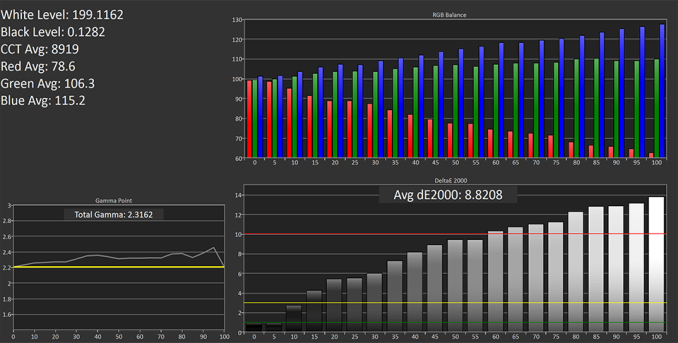

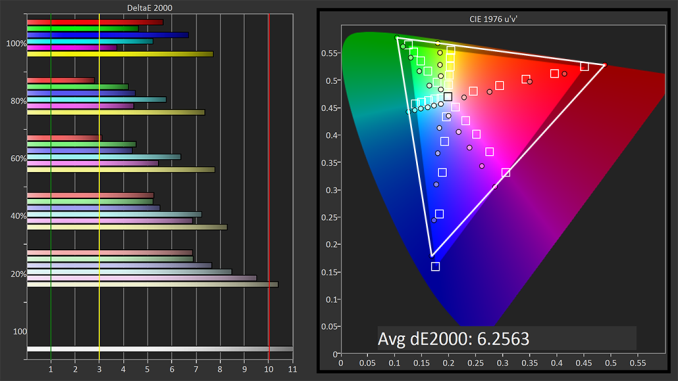
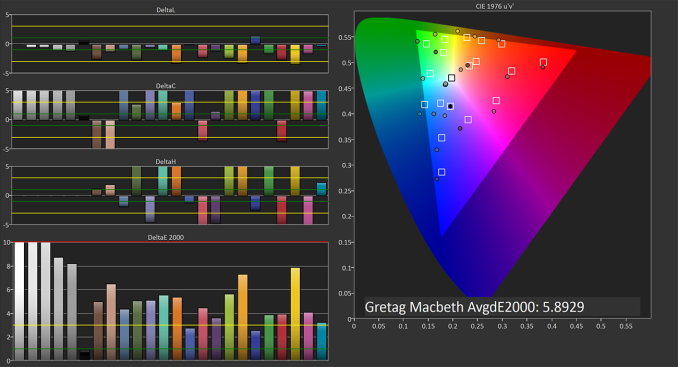

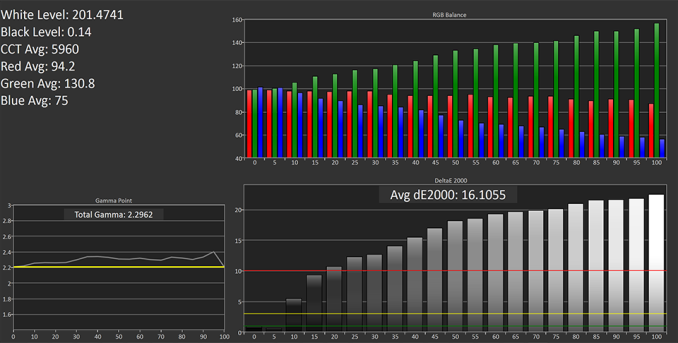








95 Comments
View All Comments
Matt Humrick - Friday, October 14, 2016 - link
That's a good point. The Smart mode selectively reduces screen brightness when using specific apps. It does not alter screen brightness for the PCMark test, which is one reason why there is not a bigger gap between it and the Performance mode; however, it does drop brightness from the calibrated 200 nits to about 100 nits when using the Chrome browser, which would increase the battery life in our web browsing battery life tests (these were run in Performance mode).prku - Friday, October 14, 2016 - link
Honor 8 is not a dual-standby dual sim phone. Please check again. it is supposed to have Dual Sim Full Active (which is a major selling point). DSFA is supposed to be present in all but Indian variations of the Honor.randomlm - Saturday, October 15, 2016 - link
Thanks for the nicely written, well balanced and non-biased review matt. This is the standard I've come to expect from anandtech that imo, some other reviewer on this site hasn't been delivering, especially on the camera portion of the review.Of course, entirely just my opinion
Feegenie - Saturday, October 15, 2016 - link
Fair.........jvl - Saturday, October 15, 2016 - link
"It’s a bit unfair to point our fingers solely at the OEMs and carriers, of course, because it was Google that created this mess and, ultimately, only Google can clean it up."What.
lagittaja - Saturday, October 29, 2016 - link
Do you even Android? Version distribution. Google can't force OEM's or carriers to update the devices.Even Android N's "auto update" doesn't really fix anything.
Why would the carrier or OEM keep updating the devices if they can just drag their feet on the ground making the update process as slow and painful as possible or just flat out not update them? Even once? The consumer will just buy a new device anyway.
Between 29th Aug and 5th Sept, of all the devices "phoning home" to Google a whopping 81.3% were running Android Lollipop 5.1 or older version.
If you take Lollipop out of the equation, 46.3% of the devices were running KitKat 4.4 or older.
If you take KitKat out of the equation, still almost 20% of the devices were running Jelly Bean 4.3 or older..
https://developer.android.com/about/dashboards/ind...
http://www.infoworld.com/article/3072591/android/g...
Google even tried to downplay the issue during May I/O event saying "it's not fragmented".
https://data.apteligent.com/download-report?report...
Yeah, that looks SO much better... 80%+ of devices being used are running Lollipop or older. A third of the devices being used are running KitKat or older..
And saying yeah, well only KitKat, Lollipop and Marshmallow matter because reasons and hey look at that 92% of devices being "used" are running Android OS's that "matter" and oh hey in contrast to iOS there's only iOS8 and iOS9 that matter and oh hey that comprises 97% of the iOS traffic. We're just as good as Apple! Yey us!
Uhm no.. Apple keeps it tidy because they have CONTROL...
iOS 9 only runs on devices that are from 2011 or older.
iOS 10 only runs on devices that are from 2012 or older.
Google has no control what so ever of Android devices that are not made by them.
Bloody hell, there's still Android devices sold new that run KitKat. And guess what, most of them are not going to receive a single damng update because the OEM doesn't give a flying fuck about it.
Look at Apple, look at what devices they sell. Guess what, they run iOS 10 or are just waiting to be turned on so they can nag you that there's a pending update.
With Android Nougat Google should have grabbed the "bull by the horns" and just fix the God damn problem.
They should have made a way for them to be able to at least deliver the critical security updates to the devices "automagically" no matter what sort of customizations OEM's or carriers have done.
I don't have the faintest idea of how that could be done but it's the least that needs to be done.
P.S. I'm an Android user and always will be. I don't like Apple's devices or their OS but I like how good control they have over their devices.
phuzi0n - Sunday, October 16, 2016 - link
Is this a phone review or a car review? We could do without all the car analogies in the first three paragraphs.Badelhas - Sunday, October 16, 2016 - link
I hate these Chinese UI skins which are iPhone iOS imitations. But that's just me.nkuehn - Friday, October 21, 2016 - link
Matt, did you also do testing on the Cellular Performance? Anandtech is famously good at really testing and not just testin, but I'm totally missing this part. I'm asking because some other reviewers had serious issues with the LTE performance of the device, losing LTE connection in well covered area etc.Maybe partner with people like http://cellularinsights.com/ - they have the testing hardware for cell that you have for displays and all the other stuff.
Savanah - Thursday, October 27, 2016 - link
I am so glad I went for the Moto Z Play instead of the Oneplus 3. It has a premium build quality, great display, awesome battery life, buttery smooth performance and decent cameras. It also excels in areas we tend to take for granted like call quality and signal retention. And to top it off it is bound to get fastest Android updates of any non Nexus/Pixel device. What else can you wish for in a $350 smart phone?